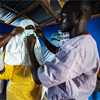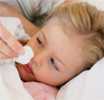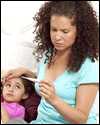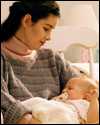Newsroom Formatted Articles - Diseases & Conditions
Mat releases (also known as matte releases or formatted releases) are formatted, ready-to-print articles that are free to use in any publication. CDC′s Formatted Release Library has articles on a variety of important health topics.
Please call (404) 639-3286 or e-mail media@cdc.gov with the title of the mat release you would like to use and the name of your publication. We will get back to you within one business day with a watermark-free copy.
Remember to check back for new articles or e-mail media@cdc.gov to get on our distribution list and receive updates when articles are added.
Ebola: From Ground Zero to Zero Cases
 The CDC Museum has launched an exhibition of the historic West African Ebola epidemic. Visitors take a journey from the early days of the outbreak through its terrifying spread through crowded urban centers.
The CDC Museum has launched an exhibition of the historic West African Ebola epidemic. Visitors take a journey from the early days of the outbreak through its terrifying spread through crowded urban centers.
Preventing Cancer for CDC – and for Me

Screening is recommended for men and women beginning at 50 and continuing until 75. Among men and women combined, colorectal cancer is the second leading cancer killer in the United States.
Parents: Learn the Facts about Enterovirus D68
 Every year, millions of children in the United States get enterovirus infections that can cause coughing, sneezing, and fever. This year, children throughout the country have gotten sick with respiratory illnesses caused by enterovirus D-68 (EV-D68).
Every year, millions of children in the United States get enterovirus infections that can cause coughing, sneezing, and fever. This year, children throughout the country have gotten sick with respiratory illnesses caused by enterovirus D-68 (EV-D68).
CDC Continues Tips From Former Smokers Campaign
 The 2013 Tips From Former Smokers campaign is a continuation of last year’s very successful campaign. It was developed to share stories from real people about the dangers of smoking and secondhand smoke. Find more articles to use in your communications efforts on the Tips campaign website at Matte Articles.
The 2013 Tips From Former Smokers campaign is a continuation of last year’s very successful campaign. It was developed to share stories from real people about the dangers of smoking and secondhand smoke. Find more articles to use in your communications efforts on the Tips campaign website at Matte Articles.
Building on a Public Health Achievement: Folic Acid
 Worldwide, more than 300,000 babies are born every year with neural tube defects (NTDs), which include spina bifida and anencephaly, a birth defect of the brain.
Worldwide, more than 300,000 babies are born every year with neural tube defects (NTDs), which include spina bifida and anencephaly, a birth defect of the brain.
Preventing Infant Deaths from Congenital Heart Defects
 In the United States, every 15 minutes a baby is born with a congenital heart defect, the most common type of birth defect in this country.
In the United States, every 15 minutes a baby is born with a congenital heart defect, the most common type of birth defect in this country.
Turtles and other reptiles are risky pets
 Turtles are colorful and cute and are often kept as pets. However, many people don’t know that turtles and other reptiles like snakes and lizards can carry harmful germs that can make people very sick.
Turtles are colorful and cute and are often kept as pets. However, many people don’t know that turtles and other reptiles like snakes and lizards can carry harmful germs that can make people very sick.
New CDC Program Created To Help Cancer Patients Prevent Infections
 There is important news for cancer patients undergoing chemotherapy. Did you know that one of the most dangerous side effects of chemotherapy cannot be seen? That’s right; a low white blood cell count puts cancer patients at a higher risk for getting an infection. This condition, called neutropenia, is common after receiving chemotherapy.
There is important news for cancer patients undergoing chemotherapy. Did you know that one of the most dangerous side effects of chemotherapy cannot be seen? That’s right; a low white blood cell count puts cancer patients at a higher risk for getting an infection. This condition, called neutropenia, is common after receiving chemotherapy.
Got Raw Milk? Don’t Drink It!
 Although many foods can be enjoyed raw, milk and products made from it should never be one of them. Raw milk, or milk that has not been pasteurized (heated to kill germs), is one of the riskiest sources of foodborne illness and can be contaminated with a variety of germs that can make people sick.
Although many foods can be enjoyed raw, milk and products made from it should never be one of them. Raw milk, or milk that has not been pasteurized (heated to kill germs), is one of the riskiest sources of foodborne illness and can be contaminated with a variety of germs that can make people sick.
CDC: Decades of saving lives and protecting people
 For more than six decades, CDC has guarded people against infectious and noninfectious diseases, responded to dangers caused by injuries, workplace hazards, disabilities and environmental health threats, thereby increasing opportunities for longer, more productive lives for all people.
For more than six decades, CDC has guarded people against infectious and noninfectious diseases, responded to dangers caused by injuries, workplace hazards, disabilities and environmental health threats, thereby increasing opportunities for longer, more productive lives for all people.
Coronary Heart Disease: A Burden for American Indians and Alaska Natives
 Heart disease and cancer are the leading causes of death for American Indians and Alaska Natives (AI/AN). A variety of health disparities affect AI/AN communities, including, disproportionately high prevalence for diabetes, suicide, teenage pregnancy, infant death, unintentional and motor vehicle injuries, chronic liver disease, cirrhosis, and coronary heart disease.
Heart disease and cancer are the leading causes of death for American Indians and Alaska Natives (AI/AN). A variety of health disparities affect AI/AN communities, including, disproportionately high prevalence for diabetes, suicide, teenage pregnancy, infant death, unintentional and motor vehicle injuries, chronic liver disease, cirrhosis, and coronary heart disease.
Peep, chirp, quack! What you should know about Salmonella if you keep live poultry
 It’s not unusual to see soft and cute baby poultry put on display in agricultural feed stores, especially during the spring. But most people do not realize that live poultry (chicks, chickens, ducks, ducklings, geese, turkeys) can be a source of human Salmonella infections, especially for children.
It’s not unusual to see soft and cute baby poultry put on display in agricultural feed stores, especially during the spring. But most people do not realize that live poultry (chicks, chickens, ducks, ducklings, geese, turkeys) can be a source of human Salmonella infections, especially for children.
Disease outbreak at a summer camp highlights ways to stay healthy
 For many children, summer means spending weeks or months at camp. Though summer camp can be a great place for kids or young adults to learn new skills, make friends, and participate in outdoor activities, camp can also provide the perfect environment for spreading germs.
For many children, summer means spending weeks or months at camp. Though summer camp can be a great place for kids or young adults to learn new skills, make friends, and participate in outdoor activities, camp can also provide the perfect environment for spreading germs.
Pregnant or older? Be Safe with ready-to-eat meats
 Cook-outs and picnics are great ways to share quality time with friends and family. However, it’s important to know that ready-to-eat hot dogs, lunch meats, and cold cuts may not be safe for certain groups of people. These and certain other foods can be contaminated with the bacteria Listeria, which causes listeriosis, a serious disease that primarily affects older adults, adults with weakened immune systems, pregnant women and newborns.
Cook-outs and picnics are great ways to share quality time with friends and family. However, it’s important to know that ready-to-eat hot dogs, lunch meats, and cold cuts may not be safe for certain groups of people. These and certain other foods can be contaminated with the bacteria Listeria, which causes listeriosis, a serious disease that primarily affects older adults, adults with weakened immune systems, pregnant women and newborns.
Have Diabetes. Will Travel.
 Heading out of town? Leaving your troubles behind? Off on an important business trip? Whenever you travel, your diabetes comes along with you. And while having diabetes shouldn’t stop you from traveling in style, you will have to do some careful planning. Here are some helpful diabetes travel tips from the National Diabetes Education Program.
Heading out of town? Leaving your troubles behind? Off on an important business trip? Whenever you travel, your diabetes comes along with you. And while having diabetes shouldn’t stop you from traveling in style, you will have to do some careful planning. Here are some helpful diabetes travel tips from the National Diabetes Education Program.
CDC Warns That Water Frogs Can Make Your Child Sick
 Virginia Ortiz had no idea that the two African dwarf frogs in her great aunt’s aquarium could carry Salmonella bacteria, a germ that can cause serious illness in people. If she had, she would not have stored her 4-month-old baby’s bottles next to the kitchen sink where the water frogs’ aquarium was cleaned.
Virginia Ortiz had no idea that the two African dwarf frogs in her great aunt’s aquarium could carry Salmonella bacteria, a germ that can cause serious illness in people. If she had, she would not have stored her 4-month-old baby’s bottles next to the kitchen sink where the water frogs’ aquarium was cleaned.
Know the Facts: Tips for Travelers about Malaria
 World Malaria Day is observed around the world each April 25 to raise awareness about the impact of this serious, sometimes deadly disease. World Malaria Day rightly seeks to draw attention to the thousands of people at greatest risk for malaria, children and pregnant women who live in malarious areas of the world. However, people from countries without malaria, such as the United States, can also become infected when they travel to countries with malaria. This generally happens because of a lack of awareness about how to prevent malaria, not a lack of resources.
World Malaria Day is observed around the world each April 25 to raise awareness about the impact of this serious, sometimes deadly disease. World Malaria Day rightly seeks to draw attention to the thousands of people at greatest risk for malaria, children and pregnant women who live in malarious areas of the world. However, people from countries without malaria, such as the United States, can also become infected when they travel to countries with malaria. This generally happens because of a lack of awareness about how to prevent malaria, not a lack of resources.
Five Important Reasons to Vaccinate Your Child
 You want to do what is best for your children. You know about the importance of car seats, baby gates and other ways to keep them safe. But, did you know that one of the best ways to protect your children is to make sure they have all of their vaccinations?
You want to do what is best for your children. You know about the importance of car seats, baby gates and other ways to keep them safe. But, did you know that one of the best ways to protect your children is to make sure they have all of their vaccinations?
HPV vaccines offer disease protection pre-teens can grow into—now for girls and boys
 When it comes to their kids, parents are always planning. Healthy dinners. Safe activities. One plan that’s easy to make could have a tremendous benefit, even saving a life. That’s planning to have pre-teens vaccinated against HPV, the leading cause of cervical cancer in women.
When it comes to their kids, parents are always planning. Healthy dinners. Safe activities. One plan that’s easy to make could have a tremendous benefit, even saving a life. That’s planning to have pre-teens vaccinated against HPV, the leading cause of cervical cancer in women.
Whooping cough: Without booster vaccine, pre-teens at risk for lengthy, disruptive illness
 Whooping cough—or pertussis—is a serious and very contagious respiratory disease that can cause long, violent coughing fits and the characteristic “whooping” sound that follows when a person gasps for air. Whooping cough has been on the rise in pre-teens and teens. In 2009, a quarter of the 16,858 cases of pertussis reported in the United States were among 10- through 19-year-olds.
Whooping cough—or pertussis—is a serious and very contagious respiratory disease that can cause long, violent coughing fits and the characteristic “whooping” sound that follows when a person gasps for air. Whooping cough has been on the rise in pre-teens and teens. In 2009, a quarter of the 16,858 cases of pertussis reported in the United States were among 10- through 19-year-olds.
October is Breast Cancer Awareness Month
 Breast cancer is the most common cancer among women in the U.S. and the second leading cause of cancer death among women. Every year, about 200,000 new cases of breast cancer are reported nationwide and more than 40,000 women die from the disease. Getting mammograms regularly can help prevent breast cancer.
Breast cancer is the most common cancer among women in the U.S. and the second leading cause of cancer death among women. Every year, about 200,000 new cases of breast cancer are reported nationwide and more than 40,000 women die from the disease. Getting mammograms regularly can help prevent breast cancer.
NEW Flu Vaccine information for the 2010-11 Flu Season
 It’s flu season again and it is important to prepare yourself and your loved ones to avoid becoming sick. Understanding new flu vaccine information will help your family make safe and healthy decisions regarding the 2010-2011 flu season.
It’s flu season again and it is important to prepare yourself and your loved ones to avoid becoming sick. Understanding new flu vaccine information will help your family make safe and healthy decisions regarding the 2010-2011 flu season.
Whooping Cough Making a Comeback — Vaccination is Key
 Another fitful night. A mom is awake, listening to her baby cough and trying to comfort him. She will be too worried to sleep tonight. For the past four days, her baby has had trouble eating, drinking, and sleeping because of this awful cough. Tomorrow, she will miss another day of work to care for him. She wonders wearily when it will end. She is exhausted and her baby is miserable. Unfortunately, the end will not come soon because this cough is whooping cough, also called the “100-day cough” because of its long duration.
Another fitful night. A mom is awake, listening to her baby cough and trying to comfort him. She will be too worried to sleep tonight. For the past four days, her baby has had trouble eating, drinking, and sleeping because of this awful cough. Tomorrow, she will miss another day of work to care for him. She wonders wearily when it will end. She is exhausted and her baby is miserable. Unfortunately, the end will not come soon because this cough is whooping cough, also called the “100-day cough” because of its long duration.
CDC Tips for Living with Arthritis
 Arthritis is the most common cause of disability in the United States, disabling 8.6 million adults and limiting the activities of nearly 19 million adults in all. CDC’s Arthritis Program is currently working to improve the quality of life for people affected by arthritis by raising awareness about the disease and showing what they can do to management it themselves.
Arthritis is the most common cause of disability in the United States, disabling 8.6 million adults and limiting the activities of nearly 19 million adults in all. CDC’s Arthritis Program is currently working to improve the quality of life for people affected by arthritis by raising awareness about the disease and showing what they can do to management it themselves.
CDC Battles Osteoarthritis with New Public Health Agend
 Nearly 27 million Americans have Osteoarthritis (OA), a painful and potentially life-altering joint disease affecting mainly the hands, knees and hips. CDC and the Arthritis Foundation in collaboration with 75 partners recently released, A National Public Health Agenda for Osteoarthritis, a new agenda to battle this disease.
Nearly 27 million Americans have Osteoarthritis (OA), a painful and potentially life-altering joint disease affecting mainly the hands, knees and hips. CDC and the Arthritis Foundation in collaboration with 75 partners recently released, A National Public Health Agenda for Osteoarthritis, a new agenda to battle this disease.
Stop, Wash, and Go To Avoid the Flu During Travel
 2009 H1N1 (originally called ‘swine flu’) is a new flu virus that was first detected in April, 2009. On June 11, 2009, the World Health Organization (WHO) raised the worldwide pandemic alert level to Phase 6 in response to the ongoing global spread of the 2009 H1N1 virus. A Phase 6 designation indicates that a global pandemic is underway. WHO’s decision to raise the pandemic alert level to Phase 6 is a reflection of the spread of the virus, not the severity of illness caused by the virus.
2009 H1N1 (originally called ‘swine flu’) is a new flu virus that was first detected in April, 2009. On June 11, 2009, the World Health Organization (WHO) raised the worldwide pandemic alert level to Phase 6 in response to the ongoing global spread of the 2009 H1N1 virus. A Phase 6 designation indicates that a global pandemic is underway. WHO’s decision to raise the pandemic alert level to Phase 6 is a reflection of the spread of the virus, not the severity of illness caused by the virus.
Flu is Here: Take Action to Protect Yourself
 Every year, flu season occurs in the United States – but did you know that flu seasons can be different each year? Flu seasons can differ in timing, duration, or severity. This year, there is a new and very different influenza virus causing illness called 2009 H1N1 flu. CDC expects both 2009 H1N1 flu and seasonal flu to cause illness, hospital stays, and deaths this season. However, there are important steps you can take to protect yourself.
Every year, flu season occurs in the United States – but did you know that flu seasons can be different each year? Flu seasons can differ in timing, duration, or severity. This year, there is a new and very different influenza virus causing illness called 2009 H1N1 flu. CDC expects both 2009 H1N1 flu and seasonal flu to cause illness, hospital stays, and deaths this season. However, there are important steps you can take to protect yourself.
Rabies: The Silent Killer
 A young child awakens early one morning to a fluttering sound coming from the blinds covering his bedroom window. He gets out of bed and notices what looks like a small bird flopping around on the floor. The child picks up the bird and realizes that it’s not a bird but a bat and releases it out the window. Weeks later, the child develops a fever, headache, and becomes disoriented and is admitted to a hospital. Tragically, he dies two days later from what doctors diagnose as rabies. This scenario is not uncommon when it comes to humans being infected with rabies.
A young child awakens early one morning to a fluttering sound coming from the blinds covering his bedroom window. He gets out of bed and notices what looks like a small bird flopping around on the floor. The child picks up the bird and realizes that it’s not a bird but a bat and releases it out the window. Weeks later, the child develops a fever, headache, and becomes disoriented and is admitted to a hospital. Tragically, he dies two days later from what doctors diagnose as rabies. This scenario is not uncommon when it comes to humans being infected with rabies.
Protect Yourself & the People You Love from Common STDs
 There are a lot of things you can get out of an intimate relationship – human connection, understanding, love. But one thing you don’t want to get is a sexually transmitted disease (STD). STDs are caused by infections passed from one person to another through sexual contact and can be passed through oral, vaginal or anal sex. The Centers for Disease Control and Prevention (CDC) estimates that approximately 19 million new STD infections occur each year in the United States – almost half of them among young people 15-24 years of age. In addition to youth, women and minorities are also severely affected. STDs are the most commonly reported infectious diseases in the United States. Chlamydia and gonorrhea are the most common reportable STDs and can result in infertility in women.
There are a lot of things you can get out of an intimate relationship – human connection, understanding, love. But one thing you don’t want to get is a sexually transmitted disease (STD). STDs are caused by infections passed from one person to another through sexual contact and can be passed through oral, vaginal or anal sex. The Centers for Disease Control and Prevention (CDC) estimates that approximately 19 million new STD infections occur each year in the United States – almost half of them among young people 15-24 years of age. In addition to youth, women and minorities are also severely affected. STDs are the most commonly reported infectious diseases in the United States. Chlamydia and gonorrhea are the most common reportable STDs and can result in infertility in women.
Know the Truth about MRSA Skin Infections
 The truth about methicillin-resistant Staphylococcus aureus (MRSA) may surprise you. MRSA is a type of bacteria that causes skin and other kinds of infections. Sometimes called “the superbug,” MRSA is resistant to certain antibiotics, but several antibiotics still work. And many times, antibiotics aren’t even needed — doctors are often able to treat MRSA skin infections by simply draining them.
The truth about methicillin-resistant Staphylococcus aureus (MRSA) may surprise you. MRSA is a type of bacteria that causes skin and other kinds of infections. Sometimes called “the superbug,” MRSA is resistant to certain antibiotics, but several antibiotics still work. And many times, antibiotics aren’t even needed — doctors are often able to treat MRSA skin infections by simply draining them.
Protect your Child from Flu, and the Babysitter, Too!
 You′ve done your homework, researching and interviewing to find the best care for your child, but is your caregiver—nanny, babysitter, daycare worker or family member—protected against the flu?
You′ve done your homework, researching and interviewing to find the best care for your child, but is your caregiver—nanny, babysitter, daycare worker or family member—protected against the flu?
What You Don′t Know About Sickle Cell Disease
 Learning the Truth about One of the Most Common Genetic Diseases
Learning the Truth about One of the Most Common Genetic Diseases
Sickle cell disease one of the most common genetic diseases in the United States. It is estimated that more than 70,000 people have sickle cell disease and more than two million people carry the gene that allows them to pass it on to their children.
- Page last reviewed: October 15, 2014
- Page last updated: October 15, 2014
- Content source:



 ShareCompartir
ShareCompartir